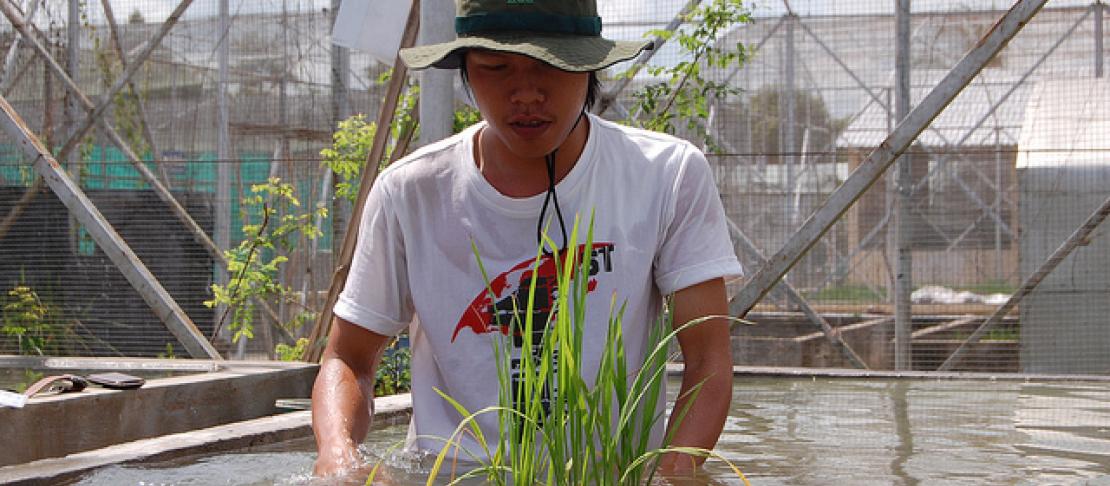Elite rice to combat flooding in Vietnam’s Mekong Delta

Researchers are creating more robust, climate-ready rice varieties that boost yields and adapt well to harsh conditions.
Rice farmer Ho Thai Benam stands outside a noisy hall, looking keenly at the on-going workshop keenly. Asked why the interest, she says: “I have children studying in the city and with low rice productivity, I don’t have enough money for their tuition.” She is here to find rice that is high yielding and that sells at a high price, she explains.
She is in the right place. The workshop going on behind her is about new and improved rice seeds resilient to harsher climate conditions, being conducted under the Climate Change Affecting Land Use in the Mekong Delta: Adaptation of Rice-based Cropping Systems (CLUES) project, led by the International Rice Research Institute (IRRI).
With flooding in the Delta - where 60 percent of Vietnam’s rice is produced - becoming more intense, frequent and complex to control, climate-smart rice varieties are what Benam and the estimated 17 million farmers living in Vietnam’s Mekong Delta need most.
As the government’s Southern Institute for Water Resources Planning contemplates spending US$2.1 billion to protect crops and people from flooding, researchers have mapped hot spots of flooding and salinity intrusion, and assessed the impact of infrastructure development on the hydrology of the lower Mekong River since 2011.
CLUES to map climate impact
“Flooding and sea water intrusion are two of the biggest threats to rice producers in the lower Mekong Delta,” said Dr Ngo Dang Phong, IRRI’s project coordinator for the CLUES project, funded by the Australian Centre for International Agricultural Research.
Over the last 30 years, Vietnamese farmers have adapted their farms and water management systems to suit the environment. But recent and forecast agro-hydrological changes, especially salt water intrusion caused by rising sea levels, threaten farming and social systems now more than ever,” Phong added.
Increasing salt water intrusion affects the operation of sluice gates, and infrastructure projects like dykes intended to protect rice crops from rising water levels. It also increases river pressure. By 2030, it is projected that salt water could contaminate 41 percent of the entire Delta.
Switching crops is not an option for many farmers who have grown rice for generations. Rice is also a central food security crop and export earner in Vietnam - with 6.7 million tons exported in 2013, fetching around US$2.9 billion in earnings.
Using a scientific process known as Marker Assisted Back-Crossing, researchers have identified favorable traits, such as high-yielding, well-adapted rice varieties, and combined them with other favorable traits to create more robust, elite rice varieties.
Based on project reports, in total, 36 single and multiple crosses have been made to combine submergence, salinity tolerance, stagnant flood tolerance, and high grain quality into high-yielding genetic backgrounds.
Dr Nguyen Thi Lang, professor at the Delta’s Cuu Long Rice Research Institute, another research partner, explains,
We release the improved rice varieties to local breeding and agricultural extension centers which multiply and provide them to farmers in their areas.”
Around 2,768 kilograms of best-bet seeds have been provided to farmers and breeding centers – mostly submergence and salt-tolerant varieties, distributed at the provincial level for extension service and breeding provision, to village clubs and workshops, and the private sector for seed multiplication.
Cutting costs and emissions from rice fields
Farmers have also been advised to intercrop rice with crops like cucumber, which cope well with different soil types, need less water and have short growth durations to fit rice cropping patterns, providing income between crops.
Experiments on different management techniques revealed a rice cultivation technology that can save water and at the same time, reduce emissions of the potent greenhouse gas methane. Known as Alternate Wetting and Drying (AWD), this technology involves draining and reflooding of rice fields, keeping sufficient water in the soil at any particular time.
AWD slashes water use by up to 30 percent, saving on irrigation-associated fuel and labor costs by about US$120 per hectare in demonstration fields. It can also cut methane emissions by an average of 47 percent compared with continuous flooding rice cultivation.
CLUES is part of a global effort to tackle climate change in the region under the CGIAR’s Research Program on Climate Change, Agriculture and Food Security (CCAFS), jointly implemented by IRRI and Can Tho University.
Other links:
Drought, submergence, and salinity management
New irrigation technique can ease drought effects for rice farmers
Georgina Smith is a Communications Specialist working for International Center for Tropical Agriculture (CIAT) based in Vietnam. She also helps with communication for CCAFS in the Southeast Asia region.
This post is part of a series related to Climate-Smart Agriculture at the UN Climate Summit. Get a full rundown of Climate-Smart Agriculture events at Climate Week NYC and follow updates on our blog and via twitter @cgiarclimate. Learn more about Climate-Smart Agriculture and Climate-Smart Villages.



